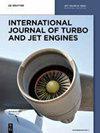Influence of inlet structure on combustion flow structure in magnesium powder fueled water ramjet engine
IF 0.9
4区 工程技术
Q4 ENGINEERING, AEROSPACE
引用次数: 0
Abstract
Abstract Different inlet structures have a significant impact on the internal flow characteristics of a solid-magnesium powder water ramjet engine. Based on the magnesium-water reaction model, a computational fluid dynamics (CFD) method is applied to establish a numerical simulation method for the internal flow field of the engine, and the internal flow characteristics of the engine under different inlet structure conditions are studied. The simulation results show that high-temperature gas can effectively promote the ignition of magnesium powder at the top of the combustion chamber, while accelerating the evaporation of the first inlet water and increasing the combustion rate of magnesium powder. The secondary inlet has the most significant effect on the temperature inside the combustion chamber. When the secondary inlet flow rate increases towards the top of the combustion chamber, it increases the amount of heat absorbed by the evaporating water at the top of the chamber, thereby reducing the temperature at the top of the combustion chamber. However, when the flow rate is low, it results in insufficient oxidizer at the top of the combustion chamber, which is unfavorable for the combustion of magnesium powder.镁粉燃料水冲压喷气发动机进气道结构对燃烧流结构的影响
不同进气道结构对固体镁粉水冲压发动机内部流动特性影响较大。基于镁水反应模型,应用计算流体动力学(CFD)方法建立了发动机内部流场的数值模拟方法,研究了不同进气道结构条件下发动机内部流动特性。仿真结果表明,高温气体能有效促进燃烧室顶部镁粉的点火,同时加速第一入口水的蒸发,提高镁粉的燃烧速度。二次进气道对燃烧室温度的影响最为显著。当二次进口流量向燃烧室顶部增加时,增加了燃烧室顶部蒸发水吸收的热量,从而降低了燃烧室顶部的温度。但当流量较低时,会导致燃烧室顶部氧化剂不足,不利于镁粉的燃烧。
本文章由计算机程序翻译,如有差异,请以英文原文为准。
求助全文
约1分钟内获得全文
求助全文
来源期刊

International Journal of Turbo & Jet-Engines
工程技术-工程:宇航
CiteScore
1.90
自引率
11.10%
发文量
36
审稿时长
6 months
期刊介绍:
The Main aim and scope of this Journal is to help improve each separate components R&D and superimpose separated results to get integrated systems by striving to reach the overall advanced design and benefits by integrating: (a) Physics, Aero, and Stealth Thermodynamics in simulations by flying unmanned or manned prototypes supported by integrated Computer Simulations based on: (b) Component R&D of: (i) Turbo and Jet-Engines, (ii) Airframe, (iii) Helmet-Aiming-Systems and Ammunition based on: (c) Anticipated New Programs Missions based on (d) IMPROVED RELIABILITY, DURABILITY, ECONOMICS, TACTICS, STRATEGIES and EDUCATION in both the civil and military domains of Turbo and Jet Engines.
The International Journal of Turbo & Jet Engines is devoted to cutting edge research in theory and design of propagation of jet aircraft. It serves as an international publication organ for new ideas, insights and results from industry and academic research on thermodynamics, combustion, behavior of related materials at high temperatures, turbine and engine design, thrust vectoring and flight control as well as energy and environmental issues.
 求助内容:
求助内容: 应助结果提醒方式:
应助结果提醒方式:


